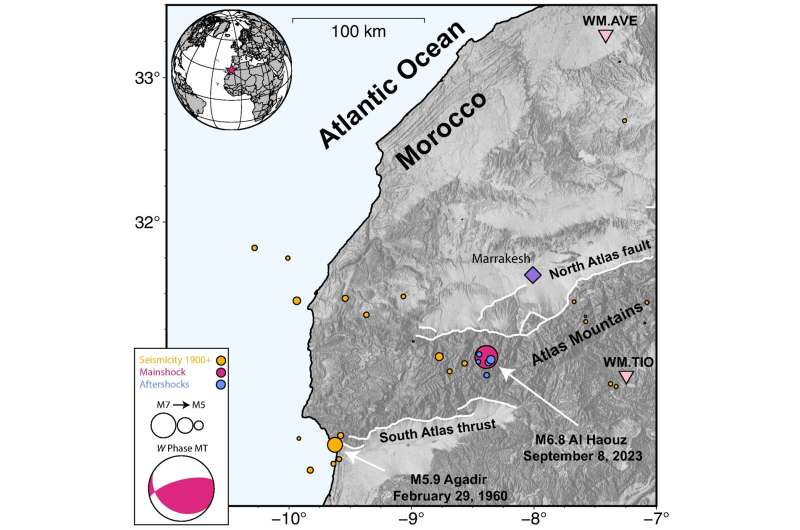This article has been reviewed according to Science X's editorial process and policies. Editors have highlighted the following attributes while ensuring the content's credibility:
fact-checked
trusted source
proofread
Morocco earthquake had unusual deep slip, according to new modeling

In their rapid characterization of the magnitude 6.8 Al Haouz earthquake in Morocco, researchers from the U.S. Geological Survey's National Earthquake Information Center (NEIC) suggest that the earthquake ruptured roughly 25 kilometers deep beneath the surface.
The USGS source modeling, published in The Seismic Record, shows a compact source for the earthquake with slip occurring between 15 and 35 kilometers deep—deeper than might be commonly expected for earthquakes in this region.
However, the September 8 earthquake took place in a region with very few historically recorded earthquakes. "In the region there's not a high rate of seismic activity, so we don't have a great idea of what the 'common' characteristics are of large earthquakes in the Atlas Mountains," said U.S. Geological Survey seismologist William Yeck.
Seismologists use information about the depth of earthquake slip to help understand the seismic hazard in a particular region. The Al Haouz earthquake rupture did not break the surface and few aftershocks were recorded, both of which make it difficult to confirm which faults were involved in the earthquake, Yeck noted.
The earthquake is named after the Moroccan province most impacted by the shaking, with violent shaking near its epicenter and very strong shaking in the city of Marrakesh. Nearly 3,000 deaths and 5,500 injuries, along with widespread damage to structures, were reported in the weeks after the earthquake.
The USGS researchers relied on teleseismic data—seismic wave data collected from stations around the globe—for their analysis. The nearest seismic station is 100 kilometers away from the earthquake epicenter, and there are only three other stations within 500 kilometers with openly available data available in real time. The researchers combined the teleseismic data with InSAR satellite data, which captures changes in ground deformation, to create several models of the earthquake source.
"We use a lot of tools to characterize these earthquakes and each one gives us specific constraints," Yeck explained. "Waveform modeling gives us the best estimate of the seismic centroid, the depth rupture, whereas InSAR can give us the precise location on the surface. It's really combining these data sets that gives us the most complete picture of the earthquake."
The modeling shows that the earthquake occurred in the lower crust about 25 kilometers beneath the western Moroccan High Atlas Mountains and was a blind rupture, meaning it did not reach the surface.
"We have some sense of the [area's] large surface faults and some sense of how they dip and how they extend at depth, but their shape can change at depth, which makes it difficult to pin this to a fault on the surface," said Yeck.
Only five aftershocks were captured in the NEIC database. "To understand the faulting in the region you want to have a good picture of the aftershocks, because then you can actually image which faults slipped," Yeck noted. "But there can still be some ambiguity where slip occurred without those aftershocks."
The researchers say that their study illustrates the benefits of regional and national networks following international data exchange standards to share real-time seismic data with the global seismic monitoring community, especially for earthquakes in remote regions with sparse seismic coverage.
More information: William L. Yeck et al, Rapid Source Characterization of the 2023 Mw 6.8 Al Haouz, Morocco, Earthquake, The Seismic Record (2023). DOI: 10.1785/0320230040
Provided by Seismological Society of America




















